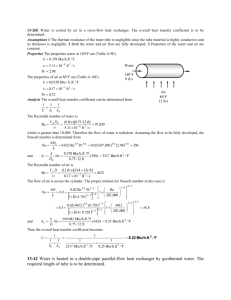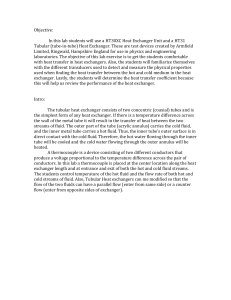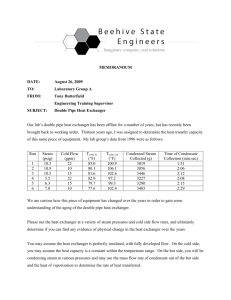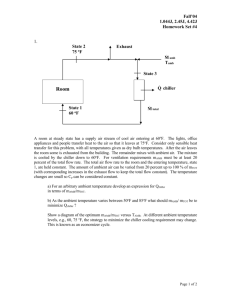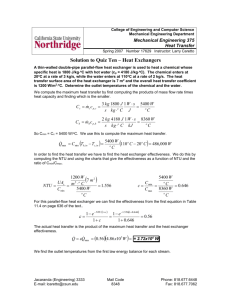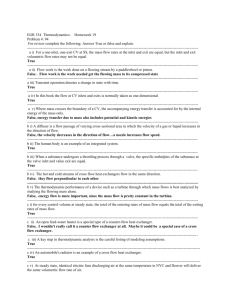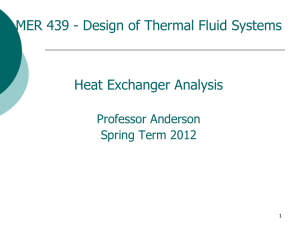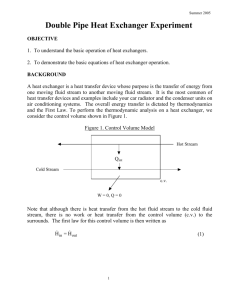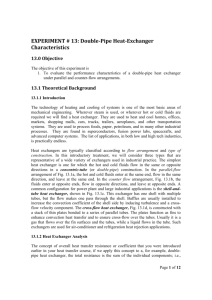Heat Transfer in Boilers & Exchangers: Calculations & Analysis
advertisement
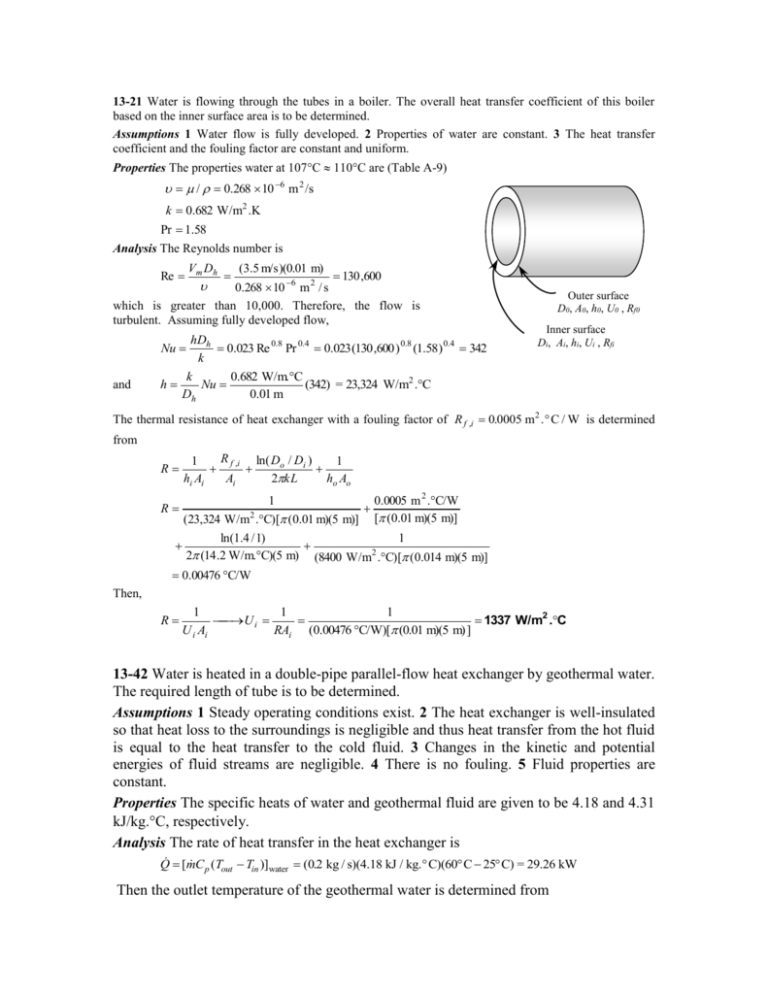
13-21 Water is flowing through the tubes in a boiler. The overall heat transfer coefficient of this boiler based on the inner surface area is to be determined. Assumptions 1 Water flow is fully developed. 2 Properties of water are constant. 3 The heat transfer coefficient and the fouling factor are constant and uniform. Properties The properties water at 107C 110C are (Table A-9) / 0.268 10 6 m 2 /s k 0.682 W/m2 .K Pr 1.58 Analysis The Reynolds number is Re Vm Dh (3.5 m/s)(0.01 m) 130 ,600 0.268 10 6 m 2 / s which is greater than 10,000. Therefore, the flow is turbulent. Assuming fully developed flow, and hDh Nu 0.023 Re 0.8 Pr 0.4 0.023 (130 ,600 ) 0.8 (1.58) 0.4 342 k k 0.682 W/m.C h Nu (342) = 23,324 W/m2 .C Dh 0.01 m Outer surface D0, A0, h0, U0 , Rf0 Inner surface Di, Ai, hi, Ui , Rfi The thermal resistance of heat exchanger with a fouling factor of R f ,i 0.0005 m 2 . C / W is determined from R R R f ,i ln( Do / Di ) 1 1 hi Ai Ai 2kL ho Ao 1 0.0005 m 2 .C/W [ (0.01 m)(5 m)] ( 23,324 W/m2 .C)[ (0.01 m)(5 m)] ln(1.4 / 1) 1 2 (14 .2 W/m.C)(5 m) (8400 W/m2 .C)[ (0.014 m)(5 m)] 0.00476 C/W Then, R 1 1 1 U i 1337 W/m2 .C U i Ai RAi (0.00476 C/W)[ (0.01 m)(5 m) ] 13-42 Water is heated in a double-pipe parallel-flow heat exchanger by geothermal water. The required length of tube is to be determined. Assumptions 1 Steady operating conditions exist. 2 The heat exchanger is well-insulated so that heat loss to the surroundings is negligible and thus heat transfer from the hot fluid is equal to the heat transfer to the cold fluid. 3 Changes in the kinetic and potential energies of fluid streams are negligible. 4 There is no fouling. 5 Fluid properties are constant. Properties The specific heats of water and geothermal fluid are given to be 4.18 and 4.31 kJ/kg.C, respectively. Analysis The rate of heat transfer in the heat exchanger is p (Tout Tin )]water (0.2 kg / s)(4.18 kJ / kg. C)(60 C 25 C) = 29.26 kW Q [mC Then the outlet temperature of the geothermal water is determined from Q 29.26 kW C p (Tin Tout )] geot.water Q [m Tout Tin 140 C 117 .4C Cp m (0.3 kg/s)(4.3 1 kJ/kg. C) The logarithmic mean temperature difference is T1 Th,in Tc,in 140 C 25 C = 115 C 60 C T2 Th,out Tc,out 117.4 C 60 C = 57.4 C and Tlm T1 T2 115 57.4 82.9 C ln( T1 / T2 ) ln(115 / 57.4) Brine 140C The surface area of the heat exchanger is determined from Q UA s Tlm As Q 29 .26 kW 0.642 m 2 UTlm (0.55 kW/m 2 )(82 .9C) Water 25C Then the length of the tube required becomes As DL L As 0.642 m 2 25.5 m D (0.008 m) 13-61E Steam is condensed by cooling water in a condenser. The rate of heat transfer, the rate of condensation of steam, and the mass flow rate of cold water are to be determined. Assumptions 1 Steady operating conditions exist. 2 The heat exchanger is well-insulated so that heat loss to the surroundings is negligible and thus heat transfer from the hot fluid is equal to the heat transfer to the cold fluid. 3 Changes in the kinetic and potential energies of fluid streams are negligible. 4 There is no fouling. 5 Fluid properties are constant. 6 The thermal resistance of the inner tube is negligible since the tube is thinwalled and highly conductive. Properties We take specific heat of water are Steam given to be 1.0 Btu/lbm.F. The heat of 90F condensation of steam at 90F is 1043 Btu/lbm. 20 Analysis (a) The log mean temperature difference 73 lbm/s is determined from F T1 Th,in Tc,out 90 F 73 F = 17 F T2 Th,out Tc,in 90 F 60 F = 30 F Tlm,CF T1 T2 17 30 22.9 F ln( T1 / T2 ) ln(17 / 30) 60F The heat transfer surface area is As 8nDL 8 50 (3 / 48 ft)(5ft) 392.7 ft 2 90F and Q UAs Tlm (600 Btu/h.ft2 .F)(392.7ft 2 )(22.9F) 5.396 106 Btu/h (b) The rate of condensation of the steam is Q 5.396 10 6 Btu/h Q (m h fg ) steam m steam 5173 lbm/h = 1.44 lbm/s h fg 1043 Btu/lbm (c) Then the mass flow rate of cold water becomes Wate r Q [m C p (Tout Tin )] cold water m cold water Q C p (Tout Tin ) 5.396 10 6 Btu/h 4.15 10 5 lbm/h 115 lbm/s (1.0 Btu/lbm. F)(73 F 60 F] 13-90 Water is heated by steam condensing in a condenser. The required length of the tube is to be determined. Assumptions 1 Steady operating conditions exist. 2 The heat exchanger is well-insulated so that heat loss to the surroundings is negligible and thus heat transfer from the hot fluid is equal to the heat transfer to the cold fluid. 3 Changes in the kinetic and potential energies of fluid streams are negligible. 4 The overall heat transfer coefficient is constant and uniform. Properties The specific heat of the water is given to be 4.18 kJ/kg.C. The heat of vaporization of water at 120C is given to be 2203 kJ/kg. Analysis (a) The temperature differences between the steam Water and the water at the two ends of the condenser are 17C T1 Th,in Tc,out 120 C 80 C = 40 C 3 kg/s T2 Th,out Tc,in 120 C 17 C = 103 C 120C The logarithmic mean temperature difference is T1 T2 40 103 Tlm 66 .6C ln( T1 / T2 ) ln( 40 /103 ) 80C The rate of heat transfer is determined from c C pc (Tc,out Tc,in ) (3 kg / s)(4.18 kJ / kg. C)(80 C 17 C) = 790.02 kW Q m The surface area of heat transfer is Q = UA s Tlm As = Q 790.02 kW = = 13.18 m 2 UTlm 0.9 kW/m 2 .C) (66 .6C) The length of tube required then becomes As DL L As 13 .18 m 2 167.8 m D (0.025 m) (b) The rate of heat transfer is c C pc (Tc,out Tc,in ) (3 kg / s)(4.18 kJ / kg. C)(80 C 17 C) = 790.02 kW Q m and the maximum rate of heat transfer rate is Q C (T T ) (12.54 W/ C)(120 C -17 C) = 1291.62 kW max min h,in c,in Then the effectiveness of this heat exchanger becomes Q 790.02 kW 0.61 Qmax 129162 . kW The NTU of this heat exchanger is determined using the relation in Table 13-5 to be NTU ln(1 ) ln(1 0.61) 0.942 The surface area is UAs NTU C min (0.942 )(12.54 kW/ C) NTU As 13 .12 m 2 C min U 0.9 kW/m 2 .C Finally, the length of tube required is As DL L As 13 .12 m 2 167 m D (0.025 m) 120C Steam 13-98 Solution is handed in class 13-102 Cold water is heated by hot oil in a shell-and-tube heat exchanger. The rate of heat transfer is to be determined using both the LMTD and NTU methods. Assumptions 1 Steady operating conditions exist. 2 The heat exchanger is well-insulated so that heat loss to the surroundings is negligible and thus heat transfer from the hot fluid is equal to the heat transfer to the cold fluid. 3 Changes in the kinetic and potential energies of fluid streams are negligible. 4 The overall heat transfer coefficient is constant and uniform. Properties The specific heats of the water and oil are given to be 4.18 and 2.2 kJ/kg.C, respectively. Analysis (a) The LMTD method in this case involves iterations, which involves the following steps: 1) Choose Th ,out 2) Calculate h C p (Th,out Th,in ) Q from Q m Hot oil 130C 3 kg/s h C p (Th,out Th,in ) 3) Calculate Th ,out from Q m 4) Calculate Tln,CF 5) Calculate Q from Q UAs FTln,CF 6) Compare to the Q calculated at step 2, and repeat until reaching the same result Result: 385 kW (b) The heat capacity rates of the hot and the cold fluids are h C ph (3 kg / s)(2.2 kJ / kg. C) 6.6 kW/ C Ch m Water 20C 3 kg/s (20 tube passes) c C pc (3 kg / s)(4.18 kJ / kg. C) 12.54 kW/ C Cc m Therefore, Cmin Ch 6.6 kW/ C and C Cmin 6.6 0.53 Cmax 12.54 Then the maximum heat transfer rate becomes Q C (T T ) (6.6 kW/ C)(130 C 20 C) 726 kW max min h,in c,in The NTU of this heat exchanger is NTU UA s (0.3 kW/m 2 .C) (20 m 2 ) 0.91 C min 6.6 kW/ C Then the effectiveness of this heat exchanger corresponding to C = 0.53 and NTU = 0.91 is determined from Fig. 13-26d to be 0.53 The actual rate of heat transfer then becomes Q Q max (0.53)(726kW) 385 kW
